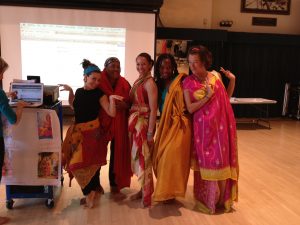
I left my first day of the 92Y Dance Education Laboratory’s workshop, “Planet Dance” leaping on air. I couldn’t stop grinning, dancing and commenting. I had a joined a group of other dancers and educators to listen to a reading of Langston Hughes’, “I’ve Known Rivers” and to view striking pictures of Pearl Primus leaping, undulating and swaying throughout her career as a dancer. My group was asked to create a dance from the emotions, feelings and concepts inspired by these sources. While dancing I felt electrified, sparked, happy and free. Later, while reflecting, I realized that the reason I experienced such joy and energy was because my story was made central in what I was being taught.
In high school I searched Langston Hughes writings for clues to my own identity. Learning about Pearl Primus’ travels to Africa and the Caribbean to reconnect to her legacy caused me to identify with her as well. For years I have been travelling to study African cultural retentions in the dance of the diaspora. Last summer I traveled around the Eastern Caribbean studying indigenous Carrib dance, Zouk and Soca. I realize now how Pearl Primius has laid a foundation and influenced me without my having known it.
Frequently the things I most care about must be studied outside of the confines of academia. In this class I felt a shift, a sharing of power and voice that allowed me to speak freely and throw myself into the work without limitations. I wonder how many more students of color would become stellar scholars if they felt their experiences were relevant and valid in academic discourse? If we made all of our students feel that their perspectives were central in what were they were learning how much more would they be willing to pass the baton to others?
Over the course of this workshop we made up Japanese dances based on folktales, danced to Native American music, worked up a furious sweat learning dance from Guinea, experimented with Flamenco, participated in discussions on the way that race, class and culture impact dance education, among other activities. By the end of the workshop I researched and presented a Bollywood lesson to the class with my group even through this style of dance was new to me. I did something totally different from what I knew because a space was created where risk taking was encouraged and practiced by everyone.
Learning something about another person’s culture is a sign of respect. It shows thoughtfulness, inclusiveness and when done well, honor. I tried to soak up every experience I had, and made plans to co-create lesson plans with my classmates during the school year because each of us have so many diverse dance experiences to share. As a teacher I want to spark my students interest and passion in dance by including their cultures in the curriculum and exposing them to each other’s traditions. In this workshop we have had a chance to learn different cultural dance styles from guest teachers, other students, media sources, through dance analysis and through the use of poetry, folktales and photography. I’m leaving this workshop charged, and ready with a whole array of lessons and projects I want to try when the new school year begins. – Olubayo Jackson ( Dance Teacher – P.S. 87)

